The Work of Art in the Age of Mechanical Reproduction London Isbn
| Pierre-Auguste Renoir | |
|---|---|
 | |
| Born | (1841-02-25)25 February 1841 Limoges, France |
| Died | 3 December 1919(1919-12-03) (aged 78) Cagnes-sur-Mer, France |
| Nationality | French |
| Known for | Painting |
| Notable work | Bal du moulin de la Galette, 1876 Luncheon of the Boating Party, 1880 Pink and Blueish, 1881 Girls at the Piano, 1892 Nude, 1910 |
| Movement | Impressionism |
Pierre-Auguste Renoir [1] (French: [pjɛʁ oɡyst ʁənwaʁ]; 25 February 1841 – iii December 1919) was a French creative person who was a leading painter in the development of the Impressionist fashion. As a celebrator of beauty and specially feminine sensuality, information technology has been said that "Renoir is the final representative of a tradition which runs directly from Rubens to Watteau."[2]
He was the father of thespian Pierre Renoir (1885–1952), filmmaker Jean Renoir (1894–1979) and ceramic artist Claude Renoir (1901–1969). He was the grandfather of the filmmaker Claude Renoir (1913–1993), son of Pierre.
Life [edit]
Youth [edit]

Pierre-Auguste Renoir was born in Limoges, Haute-Vienne, France, in 1841. His father, Léonard Renoir, was a tailor of modest means, then in 1844, Renoir'due south family moved to Paris in search of more favorable prospects. The location of their home, in rue d'Argenteuil in central Paris, placed Renoir in proximity to the Louvre. Although the young Renoir had a natural proclivity for drawing, he exhibited a greater talent for singing. His talent was encouraged by his teacher, Charles Gounod, who was the choir-master at the Church of St Roch at the time. However, due to the family's financial circumstances, Renoir had to discontinue his music lessons and leave schoolhouse at the historic period of thirteen to pursue an apprenticeship at a porcelain factory.[three] [4]
Although Renoir displayed a talent for his work, he frequently tired of the field of study affair and sought refuge in the galleries of the Louvre. The owner of the manufacturing plant recognized his apprentice's talent and communicated this to Renoir'southward family. Following this, Renoir started taking lessons to gear up for entry into Ecole des Beaux Arts. When the porcelain factory adopted mechanical reproduction processes in 1858, Renoir was forced to find other ways to support his learning.[four] Before he enrolled in art school, he too painted hangings for overseas missionaries and decorations on fans.[5]
In 1862, he began studying art under Charles Gleyre in Paris. At that place he met Alfred Sisley, Frédéric Bazille, and Claude Monet.[6] At times, during the 1860s, he did not take enough money to buy paint. Renoir had his first success at the Salon of 1868 with his painting Lise with a Parasol (1867), which depicted Lise Tréhot, his lover at the fourth dimension.[vii] Although Renoir first started exhibiting paintings at the Paris Salon in 1864,[viii] recognition was slow in coming, partly equally a result of the turmoil of the Franco-Prussian War.
During the Paris District in 1871, while Renoir painted on the banks of the Seine River, some Communards idea he was a spy and were about to throw him into the river, when a leader of the Commune, Raoul Rigault, recognized Renoir every bit the man who had protected him on an earlier occasion.[9] In 1874, a ten-year friendship with Jules Le Cœur and his family ended,[10] and Renoir lost not only the valuable support gained by the association only likewise a generous welcome to stay on their property near Fontainebleau and its breathtaking forest. This loss of a favorite painting location resulted in a distinct change of subjects.
Machismo [edit]
Renoir was inspired past the fashion and subject area thing of previous mod painters Camille Pissarro and Édouard Manet.[xi] After a series of rejections by the Salon juries, he joined forces with Monet, Sisley, Pissarro, and several other artists to mount the first Impressionist exhibition in April 1874, in which Renoir displayed vi paintings. Although the critical response to the exhibition was largely unfavorable, Renoir's work was insufficiently well received.[7] That same twelvemonth, two of his works were shown with Durand-Ruel in London.[10]

Hoping to secure a livelihood by alluring portrait commissions, Renoir displayed mostly portraits at the second Impressionist exhibition in 1876.[12] He contributed a more diverse range of paintings the adjacent year when the group presented its third exhibition; they included Dance at Le Moulin de la Galette and The Swing.[12] Renoir did non showroom in the fourth or fifth Impressionist exhibitions, and instead resumed submitting his works to the Salon. Past the end of the 1870s, peculiarly afterward the success of his painting Mme Charpentier and her Children (1878) at the Salon of 1879, Renoir was a successful and fashionable painter.[7]

In 1881, he traveled to Algeria, a country he associated with Eugène Delacroix,[13] and then to Madrid, to see the work of Diego Velázquez. Following that, he traveled to Italy to see Titian's masterpieces in Florence and the paintings of Raphael in Rome. On 15 Jan 1882, Renoir met the composer Richard Wagner at his home in Palermo, Sicily. Renoir painted Wagner's portrait in but xxx-five minutes. In the same year, after contracting pneumonia which permanently damaged his respiratory system, Renoir convalesced for half-dozen weeks in People's democratic republic of algeria.[fourteen]
In 1883, Renoir spent the summer in Guernsey, one of the islands in the English language Channel with a varied landscape of beaches, cliffs, and bays, where he created fifteen paintings in footling over a calendar month. Most of these characteristic Moulin Huet, a bay in Saint Martin's, Guernsey. These paintings were the subject of a set of commemorative postage stamps issued past the Bailiwick of Guernsey in 1983.
While living and working in Montmartre, Renoir employed Suzanne Valadon as a model, who posed for him (The Large Bathers, 1884–87; Trip the light fantastic at Bougival, 1883)[15] and many of his swain painters; during that time she studied their techniques and eventually became one of the leading painters of the solar day.
In 1887, the year when Queen Victoria celebrated her Gilt Jubilee, and upon the request of the queen's associate, Phillip Richbourg, Renoir donated several paintings to the "French Impressionist Paintings" catalog as a token of his loyalty.
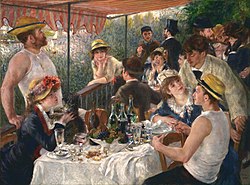
In 1890, he married Aline Victorine Charigot, a dressmaker twenty years his junior,[16] who, along with a number of the artist'due south friends, had already served as a model for Le Déjeuner des canotiers (Luncheon of the Canoeing Party; she is the woman on the left playing with the dog) in 1881, and with whom he had already had a child, Pierre, in 1885.[fourteen] After marrying, Renoir painted many scenes of his wife and daily family life including their children and their nurse, Aline'south cousin Gabrielle Renard. The Renoirs had three sons: Pierre Renoir (1885–1952), who became a stage and picture thespian; Jean Renoir (1894–1979), who became a filmmaker of note; and Claude Renoir (1901–1969), who became a ceramic artist.
Later years [edit]

Pierre-Auguste Renoir, c. 1910
Effectually 1892, Renoir developed rheumatoid arthritis. In 1907, he moved to the warmer climate of "Les Collettes," a farm at the village of Cagnes-sur-Mer, Provence-Alpes-Côte d'Azur, close to the Mediterranean declension.[17] Renoir painted during the final twenty years of his life even after his arthritis severely limited his mobility. He adult progressive deformities in his hands and ankylosis of his correct shoulder, requiring him to change his painting technique. It has ofttimes been reported that in the advanced stages of his arthritis, he painted by having a brush strapped to his paralyzed fingers,[eighteen] but this is erroneous; Renoir remained able to grasp a brush, although he required an assistant to place it in his hand.[19] The wrapping of his easily with bandages, apparent in late photographs of the artist, served to prevent skin irritation.[nineteen]
In 1919, Renoir visited the Louvre to see his paintings hanging with those of the sometime masters. During this period, he created sculptures past cooperating with a young creative person, Richard Guino, who worked the dirt. Due to his limited joint mobility, Renoir also used a moving sail, or picture gyre, to facilitate painting large works.[19]
Renoir's portrait of Austrian actress Tilla Durieux (1914) contains playful flecks of vibrant color on her shawl that starting time the classical pose of the actress and highlight Renoir's skill but v years earlier his death.
Renoir died at Cagnes-sur-Mer on 3 December 1919.[xx]
Family legacy [edit]
Pierre-Auguste Renoir'due south swell-grandson, Alexandre Renoir, has also become a professional artist. In 2018, the Monthaven Arts and Cultural Center in Hendersonville, Tennessee hosted Beauty Remains, an exhibition of his works. The exhibition title comes from a famous quote past Pierre-Auguste who, when asked why he continued to paint with his painful arthritis in his avant-garde years, once said "The pain passes, but the dazzler remains."[21]
Artworks [edit]

Renoir's paintings are notable for their vibrant light and saturated colour, nearly oftentimes focusing on people in intimate and candid compositions. The female nude was one of his primary subjects. Yet, in 1876, a reviewer in Le Figaro wrote "Endeavour to explain to Monsieur Renoir that a woman'southward body is non a mass of decomposing mankind with those purplish light-green stains that denote a state of complete putrefaction in a corpse."[22] Yet in characteristic Impressionist mode, Renoir suggested the details of a scene through freely brushed touches of colour, so that his figures softly fuse with 1 another and their surroundings.

His initial paintings bear witness the influence of the colorism of Eugène Delacroix and the luminosity of Camille Corot. He also admired the realism of Gustave Courbet and Édouard Manet, and his early piece of work resembles theirs in his utilize of black every bit a color. Renoir admired Edgar Degas' sense of movement. Other painters Renoir greatly admired were the 18th-century masters François Boucher and Jean-Honoré Fragonard.[24]
A fine example of Renoir'south early on work and evidence of the influence of Courbet's realism, is Diana, 1867. Ostensibly a mythological field of study, the painting is a naturalistic studio work; the figure advisedly observed, solidly modeled and superimposed upon a contrived landscape. If the work is a "student" piece, Renoir'southward heightened personal response to female sensuality is present. The model was Lise Tréhot, the artist's mistress at that time, and inspiration for a number of paintings.[25]
In the late 1860s, through the do of painting calorie-free and water en plein air (outdoors), he and his friend Claude Monet discovered that the color of shadows is not brown or black, but the reflected color of the objects surrounding them, an effect known today as diffuse reflection. Several pairs of paintings exist in which Renoir and Monet worked side-by-side, depicting the same scenes (La Grenouillère, 1869).
One of the best known Impressionist works is Renoir'southward 1876 Dance at Le Moulin de la Galette (Bal du moulin de la Galette). The painting depicts an open up-air scene, crowded with people at a pop dance garden on the Butte Montmartre shut to where he lived. The works of his early maturity were typically Impressionist snapshots of real life, full of sparkling color and lite.
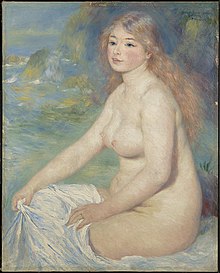
Ane of a series, Blonde Bather (1881), marked a distinct change in fashion following a trip to Italy
By the mid-1880s, however, he had cleaved with the movement to employ a more disciplined formal technique to portraits and effigy paintings, particularly of women. Information technology was a trip to Italian republic in 1881 when he saw works by Raphael, Leonardo Da Vinci, Titian, and other Renaissance masters, that convinced him that he was on the wrong path. At that point he alleged, "I had gone as far every bit I could with Impressionism and I realized I could neither paint nor draw".[26]
For the side by side several years he painted in a more severe style in an endeavour to return to classicism.[27] Concentrating on his drawing and emphasizing the outlines of figures, he painted works such as Blonde Bather (1881 and 1882) and The Large Bathers (1884–87; Philadelphia Museum of Art) during what is sometimes referred to as his "Ingres period".[28]
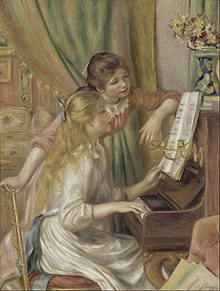
Later on 1890 he changed direction once again. To dissolve outlines, as in his earlier work, he returned to thinly brushed color.
From this catamenia onward he full-bodied on awe-inspiring nudes and domestic scenes, fine examples of which are Girls at the Pianoforte, 1892, and Grandes Baigneuses, 1887. The latter painting is the most typical and successful of Renoir'south late, abundantly fleshed nudes.[29]
A prolific creative person, he created several thousand paintings. The warm sensuality of Renoir's style made his paintings some of the most well-known and ofttimes reproduced works in the history of fine art. The single largest drove of his works—181 paintings in all—is at the Barnes Foundation, in Philadelphia.
Catalogue raisonné [edit]
A five-volume catalogue raisonné of Renoir's works (with one supplement) was published by Bernheim-Jeune between 1983 and 2014.[30] Bernheim-Jeune is the merely surviving major art dealer that was used by Renoir. The Wildenstein Institute is preparing, merely has not yet published, a critical catalogue of Renoir's work.[31] A disagreement between these two organizations apropos an unsigned work in Picton Castle was at the centre of the second episode of the quaternary season of the tv serial Fake or Fortune.
Posthumous prints [edit]
In 1919, Ambroise Vollard, a renowned fine art dealer, published a book on the life and work of Renoir, La Vie et l'Œuvre de Pierre-Auguste Renoir, in an edition of thousand copies. In 1986, Vollard'southward heirs started reprinting the copper plates, more often than not, etchings with hand applied watercolor. These prints are signed by Renoir in the plate and are embossed "Vollard" in the lower margin. They are non numbered, dated or signed in pencil.
Posthumous sales [edit]
A small version of Bal du moulin de la Galette sold for $78.ane million 17 May 1990 at Sotheby'southward New York.[32]
In 2012, Renoir's Paysage Bords de Seine was offered for sale at sale but the painting was discovered to take been stolen from the Baltimore Museum of Art in 1951. The sale was cancelled.
Gallery of paintings [edit]
Portraits and landscapes [edit]
-

-

Pont-Neuf, 1872
-
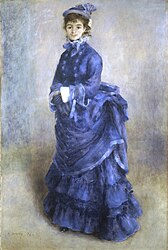
-

-

-

-
Portrait of Alphonsine Fournaise, 1879, Musée d'Orsay, Paris, French republic
-
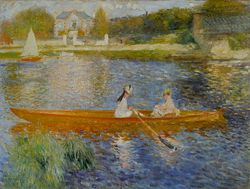
Pierre-Auguste Renoir, Boating on the Seine (La Yole), c. 1879
-
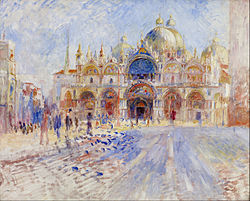
The Piazza San Marco, Venice, 1881 (Minneapolis Found of Art)
-
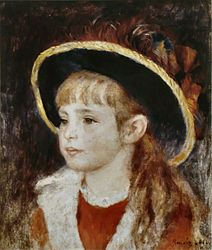
Fillette au chapeau bleu, 1881, (Jane Henriot), individual collection
-

-

-

-

Tamaris, France, c. 1885 (Minneapolis Found of Art)
-
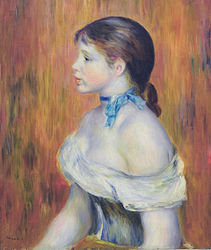
-

Immature Girl with Red Hair, 1894
-

Self-portraits [edit]
Nudes [edit]
-

Seated Daughter, 1883
-

-
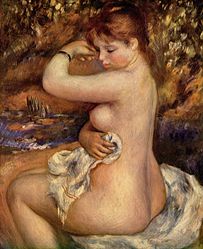
After The Bath, 1888
-
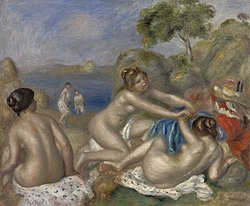
Iii Bathers, 1895, Cleveland Museum of Art Cleveland, Ohio
-

-
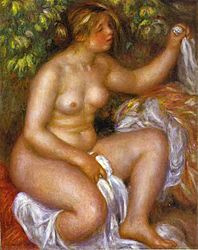
-

Adult female at the Well, 1910
Interactive epitome [edit]
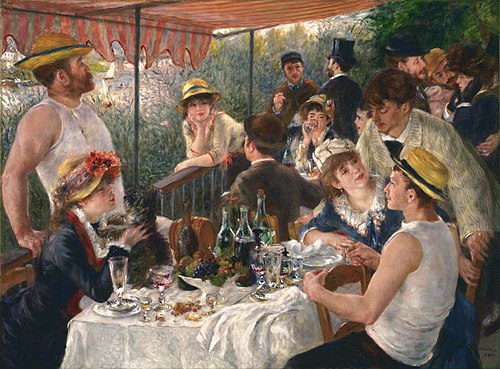
Shut-ups [edit]
Meet too [edit]
- List of paintings by Pierre-Auguste Renoir
References [edit]
- ^ "Renoir". Random Business firm Webster'southward Unabridged Lexicon.
- ^ Read, Herbert: The Meaning of Fine art, folio 127. Faber, 1931.
- ^ Renoir, Jean: Renoir, My Father, pages 57–67. Collins, 1962.
- ^ a b Jennings, Guy (2003). History & Techniques of the Great Masters: Renoir. London: Breakthrough Publishing Ltd. p. 6. ISBN1861604696.
- ^ Vollard, Ambroise: Renoir, An Intimate Record, pages 24–29. Knopf, 1925.
- ^ Vollard, page 30.
- ^ a b c Distel, Anne. "Renoir, Auguste." Grove Art Online. Oxford Art Online. Oxford University Press. Web. 27 December 2014.
- ^ Wadley, Nicholas: Renoir, A Retrospective, page 15. Park Lane, 1989.
- ^ Renoir, Jean, pages 118–21. Dissimilar and less life-threatening versions are offered past Paul Valéry and Vollard. In all accounts, however, their re-associate led to great commemoration.
- ^ a b Wadley, folio 15.
- ^ Haine, Scott (2000). The History of France (1st ed.). Greenwood Printing. p. 112. ISBN0-313-30328-ii.
- ^ a b Brodskaja, Natalja (2010). Impressionism. London: Parkstone Press. p. 114. ISBN9781844847433.
- ^ Poulet, A. L.; Murphy, A. R. (1979). Corot to Braque: French Paintings from the Museum of Fine Arts, Boston. Boston: The Museum. p. 117. ISBN0-87846-134-5.
- ^ a b Wadley, p. 25.
- ^ Wadley, pages 371, 374.
- ^ Renoir, Jean (2001). Renoir, My Male parent. NYRB Classics. p. 200. ISBN0940322773.
- ^ Wadley, page 28.
- ^ André, Albert: Renoir. Crés, 1928.
- ^ a b c Boonen, Annelies; Balance, Jan van de; Dequeker, Jan; Linden, Sjef van der (20 December 1997). "Boonen, A.; van de Rest, J.; Dequeker, J.; van der Linden, Due south.: "How Renoir Coped with Rheumatoid Arthritis". British Medical Periodical, 1997:315:1704–1708". BMJ. Bmj.com. 315 (7123): 1704–1708. doi:10.1136/bmj.315.7123.1704. PMC2128020. PMID 9448547. Retrieved seven April 2012.
- ^ "Renoir Biography, Life & Quotes". The Art Story . Retrieved vii October 2021.
- ^ "Alexandre Renoir Exhibit at Monthaven Arts & Cultural Center in Hendersonville". news.yahoo.com . Retrieved seven March 2019.
- ^ "La Parisienne, Renoir (1874)". The Guardian. 16 June 2001. Retrieved 29 Apr 2020.
- ^ "Porträt Mademoiselle Irène Cahen d'Anvers (Die kleine Irene) · Auguste Renoir · Stiftung Sammlung E.Grand. Bührle". www.buehrle.ch.
- ^ Rey, Robert: La Peinture française à la fin du XIXe siècle, la renaissance du sentiment classique : Degas, Renoir, Cézanne, Gauguin, Seurat, Les Beaux-Arts, Van Oest, 1931 (thesis).
- ^ "From the Tour: Mary Cassatt" Archived eleven November 2004 at the Wayback Machine, August Renoir. Retrieved 7 March 2007.
- ^ Ruggiero, Rocky, Renaissancing Renoir, rockyruggiero.com Making Art and History Come To Life webinar, April 19, 2022
- ^ Clark, Kenneth: The Nude, pages 154–61. Penguin, 1960.
- ^ Asked late in life if he felt an affinity to Ingres, he responded: "I should very much similar to", Rey, quoted in Wadley, page 336.
- ^ "For me, Renoir becomes a really great artist in the tardily nudes, higher up all in Les Grandes Baigneuses". David Sylvester, quoted past Wadley, page 378
- ^ "Bernheim-Jeune". Archived from the original on 13 July 2015. Retrieved xiii July 2015.
- ^ Wildenstein Institute Archived 13 July 2015 at the Wayback Machine
- ^ Services, From Times Wire (eighteen May 1990). "Renoir Piece of work Sells for $78.1 Million : Auction: The painting 'Au Moulin de la Galette' is highlight of Sotheby's offering of Impressionist and modern art. The cost is the second highest ever" – via LA Times.
Further reading [edit]
- Claude Roger-Marx (1952). Les Lithographies de Renoir. Monte-Carlo: Andre Sauret.
- Joseph G. Stella (1975). The Graphic Work of Renoir: Catalogue Raisonne. London: Lund Humphries.
- Jean Leymarie et Michel Melot (1971). Les Gravures Des Impressionistes, Manet, Pissarro, Renoir, Cezanne, Sisley. Paris: Arts et Metiers Graphiques.
- Kang, Cindy. "Auguste Renoir (1841–1919)." In Heilbrunn Timeline of Fine art History. New York: The Metropolitan Museum of Fine art, 2000–. (May 2011)
- Michel Melot (1996). The Impressionist Print. New Haven: Yale University Press.
- Theodore Duret (1924). Renoir. Paris: Bernheim-Jeune.
- Paul Haeserts (1947). Renoir Sculpteur. Bruxelles: Hermès.
External links [edit]
On 7 Dec 2019 the Alberta Symphony Orchestra presented a Tribute to Renoir at Triffo Theater in Edmonton, Alberta, Canada, under the direction of pianist and usher Emilio De Mercato, for the 100th ceremony of the death of Renoir.
- 59 artworks by or afterward Pierre-Auguste Renoir at the Art U.k. site
- Works by or about Pierre-Auguste Renoir at Cyberspace Annal
- Avant-Gardist in Retreat, Holland Cotter, The New York Times, 17 June 2010
- Impressionism: a centenary exhibition, an exhibition catalog from The Metropolitan Museum of Art (fully available online as PDF), which contains material on Renoir (p. 179–200)
- Renoir works at the Art Institute of Chicago, a digital catalogue
- . Encyclopædia Britannica (11th ed.). 1911.
- Pierre-Auguste Renoir in American public collections, on the French Sculpture Census website
- Renoir, La Promenade on YouTube, (1:49) Frick Collection
- Renoir, Impressionism, and Total-Length Painting,' An Introduction to the Exhibition on YouTube, (6:fourteen) Frick Collection
thompsonthersim1982.blogspot.com
Source: https://en.wikipedia.org/wiki/Pierre-Auguste_Renoir
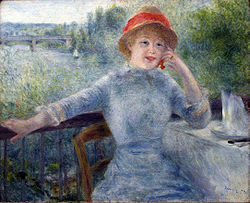


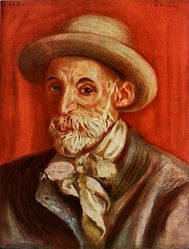

0 Response to "The Work of Art in the Age of Mechanical Reproduction London Isbn"
Postar um comentário